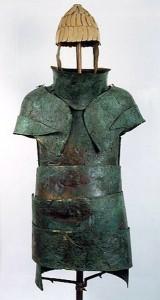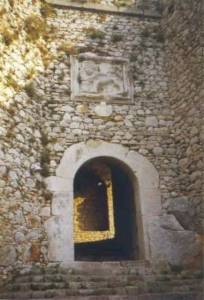Nafplion: History and its Castles
Nauplia, the area where Nafplion (or Nafplio) is, was a major center of civilization since Neolithic Times. In the Bronze Age, being the seaport of the plain in which Argos and Mycenae were situated, was also of importance. It is to this period the cuirass underneath to the right belongs. It is a unique find and consists of four parts: the collar, the shoulder pads, the breastplate and an articulated section of three broad belts, for the protection of the warrior's body. It was found in a tomb at Dendra and dates from the 15th century B.C.

Later, during Classical Times, the place was deserted. Pausanias did not mention anything of importance during his time either.
Historically, the town itself was first a holding of the Byzantine Empire. It then came under control of the Venetians in 1211AD. While remaining in their hands until 1542, when it was lost to the Turks, most of the important fortresses of the town were actually built during the second Venetian occupation in the early 1700s. Shortly after the completion of the main fortress of Palamidi, the town again fell to the Turks, who held it from 1715 and until its revolt in 1821. At the end of the War of Independence, Nafplio became the seat of the Greek government and served as such from 1829 until 1834. During this period, the first Prime Minister of Greece, Ioannis Kapodistrias, was assassinated here; and the newly installed and first King of Greece, Bavarian Prince Otto von Bayern, had his first royal residence situated here.
When visiting Nafplion, most visitors immediately are drawn to the three fortresses overlooking and standing guard over the town, two on land, and one in the sea. They were built between 1711 and 1714, and the oldest is Akronafplia, built on the site of the pre-Venetian town. Opposite is the 216-meter high, and very well preserved, Palamidi Fortress. The view from the top, in every direction, is worth climbing its 999 steps (better yet, take a taxi to the top of the paved road, then descend the steps!). The last of the three fortresses is called Bourtzi, and this is positioned in the sea, just in front of  the harbor. During the 19th century, it was used to accommodate the executioners of the convicts held in Palamidi. the harbor. During the 19th century, it was used to accommodate the executioners of the convicts held in Palamidi.
During the 20th century, Palamidi was used as a prison for political prisoners as well. When, in 1940, Greece was attacked by the Italian fascist army and later, in 1941, by the German nazis, the political prisoners, opponents to the fascist dictator ruling Greece, duly offered to serve in the Greek Army and help defend the country against the Italo-German invasion. To the authorities' historical disgrace, their offer was turned down, and, when later the country was occupied, they were handed over to the occupation forces (Greeks by Greeks!) and were executed. This was not the first time Palamidi was involved in Greek civil hostilities. Right after the Greek Revolution against Turkish rule in 1821-1828, General Theodoros Kolokotronis, one of the major heroes in this war, was kept imprisoned here, accused of High Treason by his political opponents, newly established King Otto being one of them! It was only thanks to the integrity of the Greek judges, G. Tertsetis and A. Polyzoedes, who had the stature to refuse to sign a death verdict dictated by the Palace, that Kolokotronis and his fellow warriors were spared their lives. When in Palamidi, ask to be shown to the dark dungeon where the most eminent hero of the Greek Revolution was held captive.
|
|



